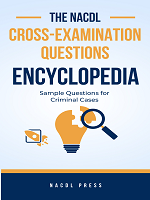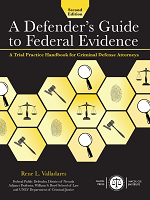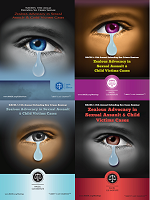Access to The Champion archive is one of many exclusive member benefits. It’s normally restricted to just NACDL members. However, this content, and others like it, is available to everyone in order to educate the public on why criminal justice reform is a necessity.
Anyone who has spent time working in today’s criminal justice system is well aware that our prisons and jails have become — as described by a recent Frontline documentary — our new asylums.
Forty years ago, America’s seriously mentally ill were housed in psychiatric hospitals that kept them too long and often without good cause. As those hospitals closed, a promise to provide care in communities went unfulfilled. At the same time, America’s prison capacity grew; it has quadrupled since 1980. People with untreated mental illness are often poor and homeless. Many commit petty crimes, creating arrest records that often lead to harsh sentences. Today some 250,000 Americans with mental illness live in prisons, the nation’s primary supplier of mental-health services.1
In fact, America’s prisons and jails currently contain three times more mentally ill people than do our psychiatric hospitals. Specifically, the National Alliance on Mental Illness has estimated that “there are roughly 283,000 persons with severe mental illnesses incarcerated in federal and state jails and prisons. In contrast, there are approximately 70,000 persons with severe mental illnesses in public psychiatric hospitals, and 30 percent of them are forensic patients.”2 Sixteen percent of state and local inmates suffer from a mental illness and most receive no treatment beyond medication.3
About half of the mentally ill who are incarcerated are arrested for non-violent offenses, such as trespassing or disorderly conduct.4 Indeed, most of these people have not committed major crimes but rather have been charged with misdemeanors or minor felonies that are directly related to their mental illness. In addition, someone who is mentally ill is almost twice as likely to be arrested than someone who does not appear to be mentally ill. For example, a Chicago study found that the police arrested 47 percent of people with mental illness as compared to only 28 percent of those without a mental illness for engaging in the same behavior.5
While some prison systems have made significant advances in mental health care services, they still face daunting obstacles, including facilities designed for punishment and a growing state fiscal crisis. In its thorough 2004 report on U.S. prisons and offenders with mental illness, Human Rights Watch made clear that its “research also indicates the persistence in many prisons of deep-rooted patterns of neglect, mistreatment, and even cavalier disregard for the well-being of vulnerable and sick human beings.”6 A recent article in The Wall Street Journal described one such facility in Oklahoma as follows:
The most unstable inmates are housed in “Fantasy Island,” the nickname for the acute-care unit. Surrounded by a 12-foot fence, it’s a prison within a prison for 108. The walls, made of unbreakable glass, allow staff to see most of the unit at a glance. There is a four-point restraint table where uncontrollable inmates can be tied down until they’re calm.
With temperatures in the teens one day earlier this year, few inmates ventured outside. Many milled around a recreation area in the zombie-like gait of the heavily medicated. Others, visibly agitated, paced back and forth and stared through the glass.
Those considered too unpredictable and uncontrollable ever to be free are locked behind thick doors with small windows. Screams, moans and chanting are normal. The noise level rises as the sun goes down and before the medication kicks in.7
Recognizing the need to address the issues created by the incarceration of persons with mental illness, Congress enacted the Mentally Ill Offender Treatment and Crime Reduction Act of 2004. The law was designed to improve access to mental health services for adult and juvenile non-violent offenders. It authorized a $50 million federal grant program for states and counties to establish more mental health courts, expand prisoners’ access to mental health treatment while incarcerated and upon re-entry into the community, provide additional resources for pre-trial jail diversion programs and related initiatives, and fund cross-training for law enforcement officials and mental health personnel dealing with adult and juvenile offenders with mental health disorders. While this is certainly a useful step, clearly much more remains to be done — not only for non-violent but also for violent offenders.
The Bazelon Center for Mental Health Law has correctly recommended that to eliminate the unnecessary and harmful criminalization of people with mental illness, we must address the substantial gaps in effective community services for the mentally ill.8 Only by providing effective mental health services within the community can we hope to stem the flow of the mentally ill into our prisons and jails.
Another technique being adopted in many states are mental health courts. As of June 2005, there were approximately 125 operational mental health courts in 36 states.9 The Bazelon Center reviewed 20 mental health courts around the country and in 2004 issued a report on the role of mental health courts in system reform. It made clear that mental health courts alone “cannot solve the underlying systemic problems that cause people with mental illnesses to be arrested and incarcerated in disproportionate numbers.”10 In addition, the Bazelon Center warned that three critical elements are needed in any community considering establishing a mental health court:
(1) treatment and service resources in the programs to which offenders will be referred;
(2) alternatives to arrest and diversion programs at the time of arrest, at jail before booking and at arraignment, to keep the court from being overwhelmed by individuals whose offenses are minor and to prevent its becoming a routine point of entry to mental health services for individuals whose real problem is the limited availability of help through more appropriate channels; and
(3) court procedures that do not have the effect of making a mental health court more coercive than a standard criminal court or more damaging to a defendant’s future prospects for housing, employment and healthcare.11
To the extent that we are involved in the development of such courts or, more generally, in addressing the problems created by the incarceration of our mentally ill clients, it is important to keep the concerns raised by the Bazelon Center in mind as well as similar concerns voiced by the National Mental Health Association.12 We need to do more to address the problems of the mentally ill and the manner in which they are treated by the criminal justice system. At the same time, we need to avoid the creation of courts that assume a coercive role, both in allocating scarce treatment resources and in further criminalizing and stigmatizing our mentally ill clients.
Notes
- Mary Beth Pfeiffer, “A Death in the Box,” The New York Times, Oct. 31, 2004.
- National Alliance on Mental Illness, Position Paper on The Criminalization of People with Mental Illness.
- Bureau of Justice Statistics, U.S. Dept. of Justice, Pub. No. NCJ 174463, Mental Health Treatment of Inmates and Probationers, 1 (July 1999).
- Robert Bernstein and Tammy Seltzer, “The Role of Mental Health Courts in System Reform,” The Bazelon Center for Mental Health Law (2004) http://www.bazelon.org /issues/criminalization/publications/mentalhealthcourts.
- Linda A. Teplin, Keeping the Peace: Police Discretion and Mentally Ill Persons, National Inst. of Just. J., July 2000, at 12.
- Ill-Equipped: U.S. Prisons and Offenders with Mental Illness, Human Rights Watch, 2 (2004).
- Gary Fields, “No Way Out: Trapped by Rules, the Mentally Ill Languish in Prison,” The Wall Street Journal, May 3, 2006.
- Bernstein & Seltzer, supra n. 4.
- Mental Health Courts: A National Snapshot, prepared by the Council of State Governments, www.consensusproject.org /mhcourts/national-snapshot.
- Bernstein & Seltzer, supra n. 4.
- Id.
- Mental Health Courts, Policy Statement by the National Mental Health Association,http://www.nmha.org/position/mentalhealthcourts.cfm. n






